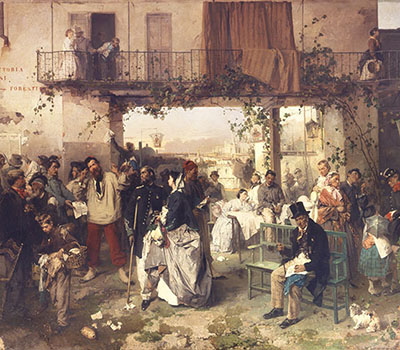Room VIII-IX-X - Civic historical collections
Rooms VIII-IX-X

The decade of preparation 1849 - 1859 and the Second War of Independence
After 1848-49 the repression of the Austrian government worsened but did not stop the patriotic movement. Meanwhile, in the Kingdom of Sardinia, various political and economic reforms were implemented under the leadership of Prime Minister Camillo Benso Conte di Cavour, a key figure in the process of Italian unification. He promoted trade and large investments in agriculture and industry; he also took part in the Crimean expedition (1853-56). Precisely this clever move allowed him to participate in the Paris peace conference and to bring the question of Italian unification to the attention of the European powers for the first time. He thus managed to stipulate an agreement with Napoleon III: in the event of an Austrian attack, France would intervene alongside the Savoy army. The hopes for unity and the political ferment of the decade 1849-59 influenced and inspired the works of the great Italian artists. The allegorical representations of unredeemed Venice and its patriotic desire for redemption from the hated domination of the Habsburg government recur very frequently throughout the pictorial production of northern Italy, in a series of seductive images halfway between the traditional allegory celebration, the historical genre and a more contemporary narrative rhetoric. A famous example is the painting Venice that hopes by Andrea Appiani Jr., presented at the annual Brera exhibition in 1861.
The Second War of Independence
Strengthened by the close agreement, Cavour provoked the government of Vienna with a series of military maneuvers near the border; Austria imposed an ultimatum on 23 April 1859, demanding the complete demobilization of the Savoy army but, rejected, Austria declared war. Gerolamo Induno, personally present in all the crucial episodes of the Italian Risorgimento, immortalized one of the most dramatic and legendary moments of the Second War of Independence, the Franco-Piedmontese victory of 4 June 1859 in Magenta over the Austrian army, a success that opened the led to the liberation of Milan, the first step towards the unification of Italy. Despite the victories achieved, fearing a German intervention to help the Austrians, Napoleon signed an armistice in Villafranca on 14 July.
The rapid spread of the news of the armistice and its echo among the common people, aroused in Domenico Induno, a great illustrator of the popular newspaper, the idea of representing an image that captured the different reactions, in particular those of a small heterogeneous group of people gathered in an out-of-town restaurant, in an extremely scenic environmental and customary setting. Lombardy, with its capital Milan, was unified with the Kingdom of Sardinia; Veneto instead remained under Austrian domination. In the meantime, revolutionary insurrections had put an end to the governments of the Duchy of Parma and Modena, the Grand Duchy of Tuscany and the Papal State; in 1860 these central territories, through a plebiscite, became part of the Kingdom of Sardinia.